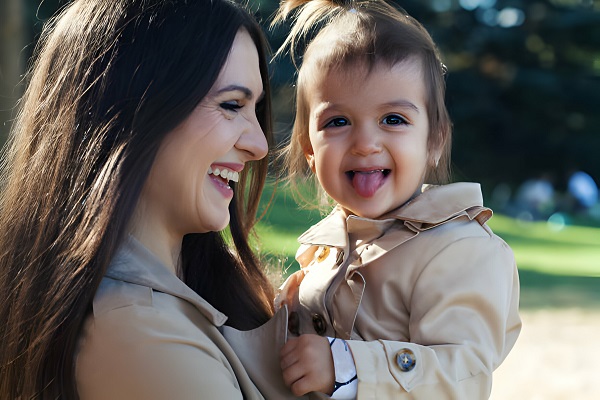Last Updated on January 1, 2025
To clean a baby’s tongue, wrap a soft, clean cloth around your finger, dip it in warm water, and gently rub the surface of the tongue in a circular motion. Repeat this process after feedings and before bedtime to maintain oral hygiene. Adjust the technique as your baby grows, ensuring comfort and safety.
Oral hygiene is a crucial aspect of a baby’s overall health, which includes the often-overlooked task of cleaning their tongue. From birth, infants are exposed to various substances, including milk, which can coat the tongue and create an environment for bacteria to grow. This comprehensive guide outlines how to effectively clean a baby’s tongue through different developmental stages, ensuring your little one maintains a healthy mouth.

Newborns (0-1 month)
Importance of Cleaning: Newborns primarily consume milk, which can leave a white residue on the tongue. This residue, if not cleaned, can lead to issues like thrush, a common yeast infection in babies’ mouths.
How to Clean: For newborns, simplicity and gentleness are key. Use a soft, clean, damp cloth or gauze. Wrap it around your index finger, dip it in warm water, and gently rub the surface of the baby’s tongue in a circular motion. There’s no need for toothpaste or any cleaning agents at this stage. It’s best to perform this cleaning after feedings and definitely before bedtime to prevent milk from sitting in the mouth overnight.
Read More – Why Babies Sleep With Their Butt In The Air?
Infants (1-6 months)
Importance of Cleaning: As your baby continues to grow, the introduction of formula or continued breastfeeding means that the risk of milk residue and oral thrush remains. Regular cleaning remains important to prevent these conditions.
How to Clean: The method remains similar to that for newborns. However, you can now introduce a silicone baby toothbrush designed for infants. These are soft, small, and have a finger-hole design, making them easy and safe to use. Just like with the cloth method, use only warm water.
Babies (6-12 months)
Importance of Cleaning: Around this age, many babies begin teething and might also start consuming solid foods. This introduces new challenges for oral hygiene, as food particles can get stuck in their mouths and between their teeth.
How to Clean: Continue using a soft, silicone baby toothbrush or a small, soft-bristled children’s toothbrush without toothpaste. After meals, gently clean the tongue, gums, and any erupted teeth. This is also a good time to gently introduce a routine that will carry over as they grow, helping them get used to the sensation of brushing.
Toddlers (1-3 years)
Importance of Cleaning: Toddlers often have a full set of baby teeth, and their diet includes a wide range of foods. Proper oral hygiene becomes even more crucial to prevent cavities and ensure the health of incoming permanent teeth.
How to Clean: At this stage, you can introduce a small, rice-sized amount of fluoride toothpaste, as recommended by dentists. Teach your toddler to spit out the toothpaste after brushing. Focus on gentle circular motions on the tongue, teeth, and gums. Encourage them to start trying to brush their own teeth under supervision to build good habits.
Read More – When Do Babies Grow Out Of Contact Naps?
Tips Across All Stages
- Gentleness is Key: The inside of a baby’s mouth is sensitive. Gentle motions prevent discomfort and make the cleaning process soothing.
- Consistency Matters: Make oral hygiene a part of the daily routine, ideally after meals and before bedtime.
- Watch for Signs of Discomfort: Any signs of irritation, excessive drooling, or resistance might indicate a problem. If these issues persist, consult a pediatric dentist.
- Use Appropriate Tools: Always choose tools appropriate for your baby’s age and developmental stage to ensure safety and effectiveness.

FAQs
How To Clean A Baby Tongue At Different Stages?
For newborns, use a soft cloth and warm water. Infants can have their tongues cleaned with a soft, silicone brush. As babies start solid foods, introduce a small, soft-bristled toothbrush. Toddlers should use a tiny amount of fluoride toothpaste, focusing on gentle brushing.
How do I clean my 3-week-old’s tongue?
Gently wrap a clean, soft cloth around your finger, moisten it with warm water, and lightly rub your 3-week-old’s tongue in a circular motion. This removes milk residue safely. Perform this after feedings and before sleep to maintain oral hygiene.
How do I clean my 1.5-year-old’s tongue?
For a 1.5-year-old, use a small, soft-bristled children’s toothbrush with a rice-sized amount of fluoride toothpaste. Brush their tongue gently in circular motions to remove food particles and bacteria. Encourage your child to spit out the toothpaste afterward.
What age should you start cleaning a baby’s mouth?
Start cleaning a baby’s mouth from birth to prevent the buildup of milk residue and bacteria. Use a soft, damp cloth to gently wipe the gums and tongue. This early routine helps establish good oral hygiene habits as your baby grows.
Why is my baby’s tongue not clean?
A baby’s tongue might not appear clean due to milk residue, oral thrush, or food particles. Regular, gentle cleaning should remove most surface buildup. If the tongue remains discolored or if there are signs of discomfort, consult a pediatrician for advice, as it might indicate an infection.
Read More – Transitioning From 3 Naps To 2: Signs Your Baby Is Ready
Conclusion
Cleaning a baby’s tongue is a simple yet essential part of their daily hygiene routine. By starting early, you instill the importance of oral care in your child, laying the foundation for healthy dental habits as they grow. Always adapt your approach as your baby develops, and don’t hesitate to consult with a pediatric dentist if you have any concerns about your baby’s oral health. With the right care and attention, you can help ensure your little one’s smile remains bright and healthy for years to come.

